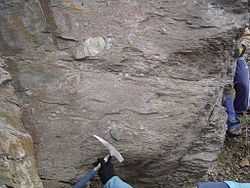Marinoan glaciation
The Marinoan glaciation was a period of worldwide glaciation that lasted from approximately 650 to 635 Ma (million years ago) during the Cryogenian period. The glaciation may have covered the entire planet, in an event called the Snowball Earth. The end of the glaciation may have been sped by the release of methane from equatorial permafrost.[2]
Origin of name and history of terminology
The name is derived from the stratigraphic terminology of the Adelaide Geosyncline (Adelaide Rift Complex) in South Australia and is taken from the Adelaide suburb of Marino. The term Marinoan Series was first used in a 1950 paper by Douglas Mawson and Reg Sprigg to subdivide the Neoproterozoic rocks of the Adelaide area and encompassed all strata from the top of the Brighton Limestone to the base of the Cambrian.[3] The corresponding time period, referred to as the Marinoan Epoch, spanned from the middle Cryogenian to the top of the Ediacaran in modern terminology. Mawson recognised a glacial episode within the Marinoan Epoch which he referred to as the Elatina glaciation after the 'Elatina Tillite' (now Elatina Formation) where he found the evidence.[4] However, the term Marinoan glaciation came into common usage because it was the glaciation that occurred during the Marinoan Epoch, as distinct from the earlier glaciation during the Sturtian Epoch (the time period of deposition of the older Sturtian Series[3]).
The term Marinoan glaciation was later applied globally to any glaciogenic formations assumed (directly or indirectly) to correlate with Mawson’s original Elatina glaciation in South Australia. Recently, there has been a move to return to the term Elatina glaciation in South Australia because of uncertainties regarding global correlation and because an Ediacaran glacial edisode (Gaskiers) also occurs within the wide ranging Marinoan Epoch.[5]
Cryogenian Snowball Earth
Emerging evidence suggests that the Earth underwent a number of glaciations during the Neoproterozoic era.[6] There were three (or possibly four) significant ice ages during the late Neoproterozoic. These periods of nearly complete glaciation of Earth are often referred to as "Snowball Earth", where it is hypothesized that at times the planet was covered by ice 1–2 km (0.62–1.24 mi) thick.[7] Of these glaciations, the Marinoan was the most significant, whereas the Sturtian glaciation was a shorter, but still worldwide glaciation. The Kaigas glaciation is considered the earliest of Cryogenian glaciations.[8] Other Cryogenian glaciations were probably small and not global as compared to the Marinoan or Sturtian glaciations.
During the Marinoan glaciation, characteristic glacial deposits indicate that Earth suffered the most severe ice ages in its history. Glaciers extended and contracted in a series of rhythmic pulses, possibly reaching as far as the equator.[9][10]
Evidence


Even though much evidence has been lost through geological changes, field investigations show evidence of the Marinoan glaciation in China, Svalbard archipelago and South Australia. In Guizhou Province, China, glacial rocks were found to be underlying and overlaying a layer of volcanic ashes which contained zircon minerals, which could be dated through radioisotopes. Glacial deposits in South Australia are approximately the same age (about 630 Ma), confirmed by similar stable carbon isotopes, mineral deposits (including sedimentary barite), and other unusual sedimentary structures.[7] Two diamictite-rich layers in the top 1 km (0.62 mi) of the 7 km (4.3 mi) Neoproterozoic strata of the northeastern Svalbard archipelago represent the first and final phases of the Marinoan glaciation.[11]
See also
References
- ↑ Smith, A.G. (2009). "Neoproterozoic timescales and stratigraphy". Geological Society, London, Special Publications (Geological Society, London, Special Publications) 326: 27–54. Bibcode:2009GSLSP.326...27S. doi:10.1144/SP326.2.
- ↑ Shields, G. A. (2008). "Palaeoclimate: Marinoan meltdown". Nature Geoscience 1 (6): 351–353. doi:10.1038/ngeo214.
- ↑ 3.0 3.1 Mawson, D.; Sprigg, R.C. (1950). "Subdivision of the Adelaide System". Australian Journal of Science 13: 69–72.
- ↑ Mawson, D. (1949). "A third occurrence of glaciation evidenced in the Adelaide System". Transactions of the Royal Society of South Australia 73: 117–121.
- ↑ Williams, G.E.; Gostin, V.A.; McKirdy, D.M.; Preiss, W.V. (2008). "The Elatina glaciation, late Cryogenian (Marinoan Epoch), South Australia: Sedimentary facies and palaeoenvironments". Precambrian Research 163 (3–4): 307–331. doi:10.1016/j.precamres.2007.12.001.
- ↑ Allen, Philip A.; Etienne, James L. (2008). "Sedimentary challenge to Snowball Earth". Nature Geoscience 1 (12): 817. Bibcode:2008NatGe...1..817A. doi:10.1038/ngeo355.
- ↑ 7.0 7.1 "New Evidence Supports Three Major Glaciation Events In The Distant Past". ScienceDaily. 2004-04-22. Retrieved 2011-06-18.
- ↑ Stern, R.J.; Avigad, D.; Miller, N.R.; Beyth, M. (2006). "Geological Society of Africa Presidential Review: Evidence for the Snowball Earth Hypothesis in the Arabian-Nubian Shield and the East African Orogen". Journal of African Earth Sciences 44: 1–20. Bibcode:2006JAfES..44....1S. doi:10.1016/j.jafrearsci.2005.10.003.
- ↑ Dave Lawrence (2003). "Microfossil lineages support sloshy snowball Earth". Geotimes. Retrieved 2011-06-18.
- ↑ "Global Glaciation Snowballed Into Giant Change in Carbon Cycle". ScienceDaily. 2010-05-02. Retrieved 2011-06-18.
- ↑ Halverson GP, Maloof AC, Hoffman PF (2004). "The Marinoan glaciation (Neoproterozoic) in northeast Svalbard" (pdf). Basin Research 16 (3): 297–324. doi:10.1111/j.1365-2117.2004.00234.x. Retrieved 2011-06-18.
| ||||||||||||||||||||||||||||||||||
| |||||||||||||||
